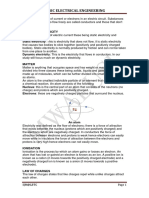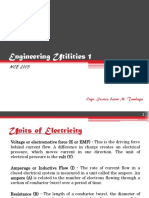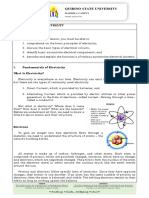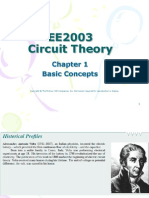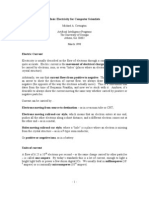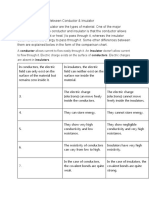Electrical Theory
Uploaded by
Matty WrobelElectrical Theory
Uploaded by
Matty WrobelSERVICE TRAINING MANUAL
ELECTRICAL
TAB TEXT THEORY
Electrical Theory
HERE
CERAMIC PRODUCTS
ELECTRICITY
Simply stated, electricity is nothing more than the process of moving electrons from one
atom to another. These moving electrons are able to do a fair amount of work, because we don’t
move one at time.
Various materials have different abilities to let go of their electrons and accept new ones.
That is referred to as conductivity. Good conductivity means the electrons can easily move from
one atom to another. Well get into later.
4 ingredients of electricity: Wire section with atoms
TAB TEXT HERE
Before we look at the basic components in electricity it is helpful to think of electricity like
water. In a water system we look at some form of pressure. When water is pumped up to a
tower it has gravitational potential energy, which will release when the water is allowed to go
downhill. The diameter and length of the pipe that carries the water to our home must be
adequately sized so it doesn’t introduce resistance for the flow of water we plan to move
through the pipe. There is a certain rate at which the water will flow through this pipe and
finally we have gallons of water as the product of the water flow.
Each of these elements to the water supply has a similar component in electricity.
Voltage (V) = pressure
TAB TEXT HERE
Voltage is a term we are all pretty familiar with but may not really understand it. Voltage is
the pressure, or force, the electrons feel which persuades them onto the next atom. It is also
called electromotive force and is often shown in equations as E. We will keep things simple here
and denote voltage with a V.
There are two basic types of voltage AC, alternating current, and DC, direct current. Virtu-
ally all power supplied to houses, schools and industrial is AC voltage. All of our kilns operate
on AC. However we take some of that AC voltage potential and convert it into much lower DC
voltage that is used for the circuit board on KM type kilns. AC voltage is generated by passing a
large coil of wire through a magnetic field.
TAB TEXT HERE
The unit of measure for voltage is a volt.
(continued)
www.skutt.com 6441 SE Johnson Creek Blvd., Portland, OR 97206 Phone (503) 774-6000 Fax (503) 774-7833 6.2 REV 9/13/99
SERVICE TRAINING MANUAL
ELECTRICAL THEORY CONTINUED
ELECTRICAL
TAB TEXT THEORY
Resistance (R or Ohms) = pipe diameter + distance
HERE
As electrons move through the wire it encounters resistance. The resistance is caused by 3
things:
1) The diameter of wire
2) The length of the wire
3) The material of the wire
1 and 2 will be discussed later in the section on wiring.
TAB TEXT HERE
The electrons in some materials are very willing to move to another atom, while the elec-
trons in other materials are extremely reluctant to allow an electron out of its grasp.
The materials that easily allow electron movement are said to have low resistance (or are
good conductors of electrons).
The opposite of a good conductor is a material that allows no electron flow between the
atoms. These materials are called insulators. The plastic wrapping on a piece of wire keeps the
electron move contained to the metal inside the wire.
Somewhere in-between a good conductor and an insulator are materials that are specially
designed to allow some electron movement. The benefit to this type of material is it will produce
heat as the voltage moves the electrons through the material. Before the electrons move they
encounter resistance. The force (V) must overcome resistance for electrons to move.
Good Conductors
TAB TEXT HERE
Silver, copper, nickel & gold
Insulators (poor conductors)
Glass, wood, porcelain and rubber
Kanthal resistance wire is somewhere in between which is why it generates heat.
Resistance increases with temperature.
Resistance is measured in ohms (R) is it also abbreviated, R.
Amperage (A) = rate
TAB TEXT HERE
In our water analogy amperage would be the rate the water flows through the pipe. It would
be measured in gallons per minute or hour. Amperage is the rate electrons are moving in the
conductor.
One way to limit the flow of water through a pipe would be to reduce the diameter of the
pipe (increasing the resistance) and we would have fewer gallons of water coming out of the
pipe in one minute than for a larger pipe.
This assumes the water pressure stays the same for both pipes. If we were to elevate the
water tower the pressure would increase and we would be able to force more water through a
pipe. So gallons per minute only means something when it is expressed relative to the water
pressure. The same is true with amperage. Amperage only has meaning when it is expressed
relative to the voltage. For example we would say a kiln draws “48 amps at 240 volts”.
TAB TEXT HERE
The unit of measure of amperage is the ampere (A), sometimes shown as “I” (intensity of
current) in electrical equations.
Page 2 of 8 6.2 REV 9/13/99
SERVICE TRAINING MANUAL
ELECTRICAL THEORY CONTINUED
ELECTRICAL
TAB TEXT THEORY
Wattage (W) = gallons
HERE
To complete the metaphor with flowing water, wattage would be like the number of gallons
received while water was flowing.
In an electric kiln it is really the wattage (which is directly proportional to BTUs) that gets
the heatwork done.
Just like with water flow an electric kiln needs a certain result (gallons or watts) in a given
time. How frustrating is it to take a shower with just a trickle of water? All of these measures
help us arrive at the wattage (also know as Power) the kiln is producing.
The Power Company will bill you on watts used for a given period of time, kilowatts (1000s
TAB TEXT HERE
of watts) used per hour. Example: a 11,500 watt load running for 1 hour would result in 11.5
kWh on your electric bill.
Ohms Law
Now that you have an understanding of the elements of electricity you probably guessed
there must be a relationship between them that is predictable, and there is. It is called Ohm’s
Law and can be expressed simply as:
Amperage = Voltage/ Resistance
These 2 equation triangles are helpful in
TAB TEXT HERE
determining the proper formula to use. For
example: by placing your finger over “R” in
triangle 1 the remaining symbols express the
formula for calculating “R”, V/A.
Voltage is the biggest factor in determining how fast a kiln with fresh heating elements will
fire. It is difficult to increase the voltage we get from the Power Company, but it isn’t difficult at
all to lower the voltage getting to the kiln. We will discuss this more in the section on Wiring an
Voltage Drops.
Resistance of the heating elements is something we can control, initially at least. As the
elements age they provide more resistance to electron flow and reduce the current. Which in turn
reduces the wattage of the kiln.
TAB TEXT HERE
Amperage and Wattage are results and can only be influenced by changing the voltage or
the resistance in the circuit.
Item Water model Electricity
Pressure or Force Pounds per square inch (PSI) Voltage (volts, V)
Resistance to flow Pipe diameter & length of pipe Resistance (ohms, R)
Rate of flow Gallons per minute (GPM) Amperage (amperes, A)
Work or result Gallons Wattage (watts, W)
Circuits
A circuit is simply an assembly of wires and components which allow current to flow
TAB TEXT HERE
(electrons to move). All circuits have these basic components:
1 voltage source
1 or more electrical loads (heaters, motors, something to consume power).
1 or more controls (switch, relay or actuator)
Page 3 of 8 6.2 REV 9/13/99
SERVICE TRAINING MANUAL
ELECTRICAL THEORY CONTINUED
ELECTRICAL
TAB TEXT THEORY
Simple Circuit
HERE
A very common circuit which we all use everyday is a lightbulb and switch circuit. It looks
like this when drawn as a schematic:
TAB TEXT HERE
Multiple Load Circuits
Now that we have a picture of a very simple circuit, there are 2 types of circuits that involve
multiple loads. Simple circuits are easy to understand but most electrical circuits are some
combination of components placed in series and parallel. The following will go into greater
detail.
Series
A series circuit is one in which each load is lined up end to end. The current must flow
through the first one then the next in a series to complete the circuit.
If a single component fails in a series circuit then power is lost to all components. And the
TAB TEXT HERE
entire circuit is de-energized. Remember those older style Christmas lights where 1 broken bulb
would turn out all the lights?
An example of a series circuit in a Skutt kiln would be 2 818 elements going to 1 infinite
switch or relay.
The working voltage is divided across each component in a series circuit. In the figure above
if both resistors (heating elements) have the same resistance in ohms then the voltage would be
TAB TEXT HERE
consumed evenly between them. Specifically, if the applied voltage is 240 then each element
would behave like a 120v element (240v/2 elements = 120volts/element). Elements would be
designed to operate on 120v instead of 240v when there are 2 elements in a series circuit.
If the 2 resistances are different, then the voltage drop across each would be proportional to
the resistance.
Parallel
Unlike series circuits a parallel circuit applies the full line voltage to each load.
TAB TEXT HERE
Page 4 of 8 6.2 REV 9/13/99
SERVICE TRAINING MANUAL
ELECTRICAL THEORY CONTINUED
ELECTRICAL
TAB TEXT THEORY
One of the main benefits of a parallel circuit is apparent when a component fails. The dam-
aged component doesn’t effect the other loads in the circuit. The remaining load(s) will still
HERE
operate as designed. This is how Christmas lights are manufactured now and it is a simple task
to find the one bulb that is burned out because all the others are still illuminated.
Wiring & Voltage Drop
Every piece of wire has some resistance. The resistance is effected by 3 things:
1) The wire gauge or diameter.
TAB TEXT HERE
2) The length of the run.
3) What the wire is made of. (A perfect conductor doesn’t exist. Copper is a good conduc-
tor for the price thus explaining its popularity).
Let’s take a closer look at each of these 3 factors individually before we look at the net effect.
Wire gauge
Every wire has a theoretical maximum flow it can take in amperes before it overheats. A wire
size that is too small will limit the flow of current and create an unnecessary hazard. Oversizing
wire for a circuit does not present any hazard what so ever.
The following table will give a few pieces of important information for discussion later.
TAB TEXT HERE
TAB TEXT HERE
Distance
Just as the diameter of the wire (pipe) can reduce or choke flow so can the length of the wire.
As a general rule of thumb we recommend going to one size larger wire for each 50 feet of run
from the circuit breaker panel to the wall outlet. These are calculations that electricians do all day
long, but we have found this minimizes the effects of distance on kiln performance.
TAB TEXT HERE
Page 5 of 8 6.2 REV 9/13/99
SERVICE TRAINING MANUAL
ELECTRICAL THEORY CONTINUED
ELECTRICAL
TAB TEXT THEORY
Bringing all 3 pieces together
HERE
There is an equation that will bring all 3 factors together into the resistance of a given length
of wire of a certain distance and composition. The equation is:
Resistance (W) = Resistivity * (length of wire / diameter of wire2)
Let’s compare copper to aluminum in a 100 foot run with a diameter of 6 gauge.
Rc = 10.4 * (100/1622) = 3.96 W
Ra = 17.0 * (100/1622) = 6.48 W
As you can see the Ra (aluminum) wire has much more resistance that the copper. This is
TAB TEXT HERE
why we recommend only working with copper wire when installing a kiln circuit.
Single and 3 Phase supplies
Electricity is generated at large facilities that spin turbines holding large coils of wire
through magnetic fields. Depending on the geometry of the magnets and coils, various fre-
quency and phase configurations are generated.
That voltage travels down main distribution lines at very high voltage (pressure) and is
transformed down to working voltages on the power pole outside your house.
TAB TEXT HERE
Single Phase Supply
TAB TEXT HERE
TAB TEXT HERE
Page 6 of 8 6.2 REV 9/13/99
SERVICE TRAINING MANUAL
ELECTRICAL THEORY CONTINUED
ELECTRICAL
TAB TEXT THEORY
You have heard the term “Hot wire” referring to a wire that has voltage potential present.
We may use this term interchangeably with Phase wire. In the following diagrams we will label
HERE
the phase wires with the standard convention of L1, L2 and L3 for Lines 1, 2 or 3.
The two most common types of power distribution are “Delta” and “Y”.
TAB TEXT HERE
120/240 = DELTA 120/208 = WYE OR “Y”
TAB TEXT HERE
Typical Kiln Circuits
Top
L1
TAB TEXT HERE
120V
Middle Bottom
N
120V
L2
1 Phase 3 Section Kiln 3 Phase 3 Section Kiln 714 Kiln
CIRCUIT BREAKERS
Circuit breakers are over current protection devices. The purpose is to interrupt voltage to a
circuit when the circuit has too much current flowing through it.
Breaker Facts
• The breaker will trip (open up) when it gets too hot.
TAB TEXT HERE
• It is very normal for a circuit breaker to get warm when the kiln is operating, but not
hot.
• Must be sized to 125% of the continuous load in Amperes.
• A 50A breaker will not run a 48A kiln.
Page 7 of 8 6.2 REV 9/13/99
SERVICE TRAINING MANUAL
ELECTRICAL THEORY CONTINUED
ELECTRICAL
TAB TEXT THEORY
Phase (or “Hot”) wires
HERE
As you open the front cover of a circuit breaker panel you will usually see 2 columns of
switches or poles. Each pole will have a rating on stamped on it. This rating will be in amperes.
Each pole is a phase wire and must be protected from overcurrent.
To get 120v we combine 1 pole with a Neutral wire. Neutral wires are usually color-coded
white.
Breaker Interlocks
TAB TEXT HERE
2 poles that are connected with small rods, make up a 208 or 240v circuit (depending on the
power distribution). If we are working with a 2 pole circuit you don’t add the values of each
pole. The capacity of the circuit is still the stamped amperage, but it is now 208-240 instead of
120. Example: 30A bridged to another 30A is not 60A single phase, it is only 30 amps single
phase.
3 phase circuits will have 3 poles all connected (i.e. 2,4 & 6 on panel)
TAB TEXT HERE
TAB TEXT HERE
TAB TEXT HERE
Page 8 of 8 6.2 REV 9/13/99
You might also like
- Volts, Amps and Ohms - Measuring ElectricityNo ratings yetVolts, Amps and Ohms - Measuring Electricity6 pages
- Engineering Utilities 1: Engr. Jessica Laine M. TumbagaNo ratings yetEngineering Utilities 1: Engr. Jessica Laine M. Tumbaga20 pages
- Basic Concepts: Heat, Light, or Mechanical Power. in Fact, Thomas Edison Himself Never Thought ElectricNo ratings yetBasic Concepts: Heat, Light, or Mechanical Power. in Fact, Thomas Edison Himself Never Thought Electric10 pages
- Agricultural Electrifiction and InstrumentationNo ratings yetAgricultural Electrifiction and Instrumentation15 pages
- Introduction To Electricity Lecture, DetailNo ratings yetIntroduction To Electricity Lecture, Detail69 pages
- Current Electricity Main Electricity Electric DevicesNo ratings yetCurrent Electricity Main Electricity Electric Devices80 pages
- Inroduction To Electricity/Electrical System, Energy, Sources and Alternative SourcesNo ratings yetInroduction To Electricity/Electrical System, Energy, Sources and Alternative Sources21 pages
- Principal Mwalusi Basic Electrical EngineeringNo ratings yetPrincipal Mwalusi Basic Electrical Engineering216 pages
- Electric Circuits: Wires To Carry ElectricityNo ratings yetElectric Circuits: Wires To Carry Electricity70 pages
- Current Electricity: Current Electricity Is The Flow of Electrons (Flow of Charge)No ratings yetCurrent Electricity: Current Electricity Is The Flow of Electrons (Flow of Charge)8 pages
- 1 Conductors, Insulators, and SemiconductorsNo ratings yet1 Conductors, Insulators, and Semiconductors20 pages
- cbseclassxthelectricity-140731151315-phpapp01No ratings yetcbseclassxthelectricity-140731151315-phpapp0126 pages
- Learning Objectives:: V I R Voltage Current ResistanceNo ratings yetLearning Objectives:: V I R Voltage Current Resistance7 pages
- Lecture 5 Electric and Magnetic Fields - Mechanical Engineering IIUINo ratings yetLecture 5 Electric and Magnetic Fields - Mechanical Engineering IIUI96 pages
- A Simplified Method For Estimating Lightning Performance of Transmission Lines100% (1)A Simplified Method For Estimating Lightning Performance of Transmission Lines15 pages
- JZ-20220423 Siliocne Composite Tape Bochure-ENNo ratings yetJZ-20220423 Siliocne Composite Tape Bochure-EN12 pages
- MH - 3034 Electrobar Elite Brochure FinalNo ratings yetMH - 3034 Electrobar Elite Brochure Final12 pages
- Simulation Analysis On Lightning Accident of 500kV DC Transmission Line Based On ATP-EMTPNo ratings yetSimulation Analysis On Lightning Accident of 500kV DC Transmission Line Based On ATP-EMTP4 pages
- Insufflator-Pneumo Sure High Flow-0620040600-Service ManualNo ratings yetInsufflator-Pneumo Sure High Flow-0620040600-Service Manual79 pages
- CHM-1-151 - Handling Manual - XH Connector - R7No ratings yetCHM-1-151 - Handling Manual - XH Connector - R713 pages
- Safety of Household and Similar Electrical Appliances: Indian StandardNo ratings yetSafety of Household and Similar Electrical Appliances: Indian Standard10 pages
- Eaton Guide Specification Notes and Instructions To SpecwriterNo ratings yetEaton Guide Specification Notes and Instructions To Specwriter10 pages
- wts Knowles - Fundamentals Capacitor book هام100% (1)wts Knowles - Fundamentals Capacitor book هام52 pages
- 380kV DiagonalConnection Brochure 50hertzNo ratings yet380kV DiagonalConnection Brochure 50hertz15 pages
- REP3 Rules For Ships - Part C Vol.2 1.1.2024No ratings yetREP3 Rules For Ships - Part C Vol.2 1.1.2024181 pages
- Product Data Sheet: Limit Switch Body ZCP - Compact - 1NC+1NO - Snap ActionNo ratings yetProduct Data Sheet: Limit Switch Body ZCP - Compact - 1NC+1NO - Snap Action2 pages
- Engineering Utilities 1: Engr. Jessica Laine M. TumbagaEngineering Utilities 1: Engr. Jessica Laine M. Tumbaga
- Basic Concepts: Heat, Light, or Mechanical Power. in Fact, Thomas Edison Himself Never Thought ElectricBasic Concepts: Heat, Light, or Mechanical Power. in Fact, Thomas Edison Himself Never Thought Electric
- Current Electricity Main Electricity Electric DevicesCurrent Electricity Main Electricity Electric Devices
- Inroduction To Electricity/Electrical System, Energy, Sources and Alternative SourcesInroduction To Electricity/Electrical System, Energy, Sources and Alternative Sources
- Current Electricity: Current Electricity Is The Flow of Electrons (Flow of Charge)Current Electricity: Current Electricity Is The Flow of Electrons (Flow of Charge)
- Learning Objectives:: V I R Voltage Current ResistanceLearning Objectives:: V I R Voltage Current Resistance
- Lecture 5 Electric and Magnetic Fields - Mechanical Engineering IIUILecture 5 Electric and Magnetic Fields - Mechanical Engineering IIUI
- A Simplified Method For Estimating Lightning Performance of Transmission LinesA Simplified Method For Estimating Lightning Performance of Transmission Lines
- Simulation Analysis On Lightning Accident of 500kV DC Transmission Line Based On ATP-EMTPSimulation Analysis On Lightning Accident of 500kV DC Transmission Line Based On ATP-EMTP
- Insufflator-Pneumo Sure High Flow-0620040600-Service ManualInsufflator-Pneumo Sure High Flow-0620040600-Service Manual
- Safety of Household and Similar Electrical Appliances: Indian StandardSafety of Household and Similar Electrical Appliances: Indian Standard
- Eaton Guide Specification Notes and Instructions To SpecwriterEaton Guide Specification Notes and Instructions To Specwriter
- Product Data Sheet: Limit Switch Body ZCP - Compact - 1NC+1NO - Snap ActionProduct Data Sheet: Limit Switch Body ZCP - Compact - 1NC+1NO - Snap Action
